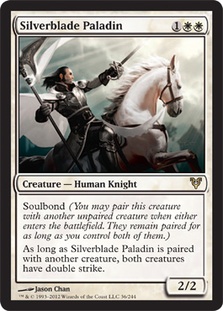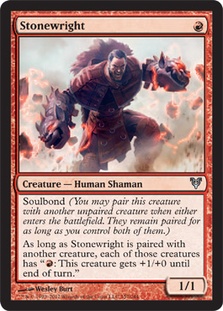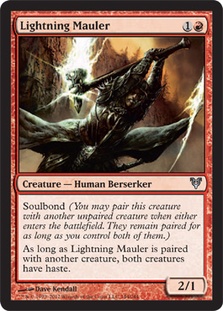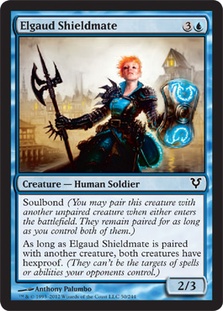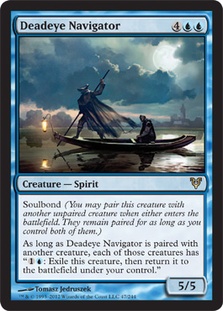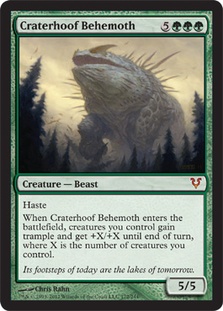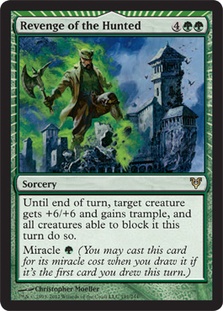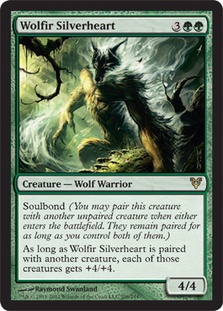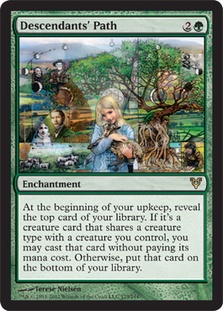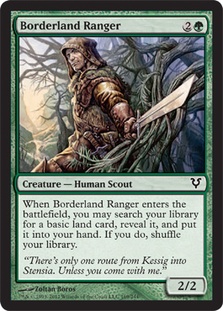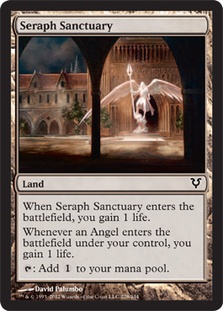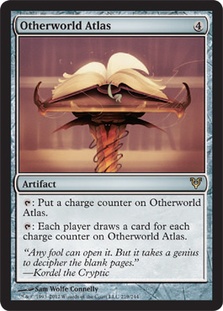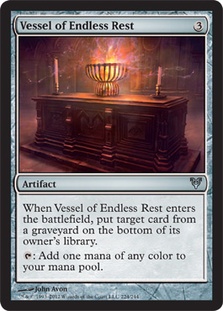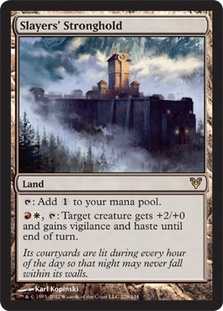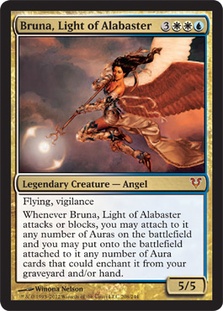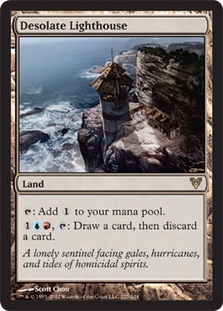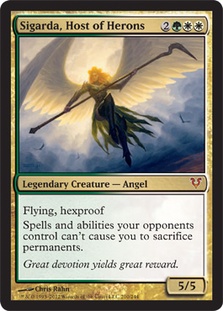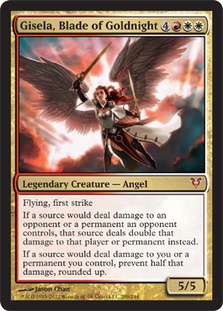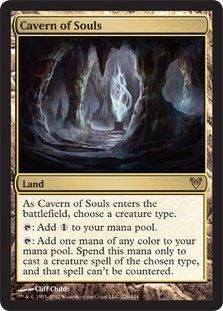Today’s article is Part 3 of reviewing Avacyn Restored. Monday, we discussed white and blue here. Wednesday, we discussed black and red here. Today, we will be covering (shockingly) green, gold, artifacts, and land. First though, a few updates from earlier in the week…
First of all, reviewing cards before you have played with them is tricky business, no question. There is a lot of information to take in and a lot of moving parts. For instance, on Wednesday in discussing the card’s applications, we mistakenly logged milling Gravecrawlers as a feature when Gloom Surgeon exiles. Fortunately, this is not a significant change to the card’s functionality, as it is a relatively corner case that the “threat” of Gloom Surgeoning is actually realized (or relevant).
Every once in a while, however, there is an element of confusion that goes along with the cards until you play against them with someone who knows how they work that has a major impact on your card evaluation. Soulbond is such a mechanic.
I, unlike more than a few people it would seem, made the mistake of trying to ascertain what the mechanic did from reading the reminder text. Worse, it was clarified to me, by people that had been told what the reminder text was not saying, that soulbond was yet another thing it was not. Until I did my first draft here at Finkel’s place two nights ago, I was under the impression that you only soulbonded with a creature once rather than rebonding whenever you are without a pair.
My sincere apologizes for any confusion over the past couple of days. Fortunately, the only soulbond card I discussed was the Paladin, which I still thought was going to be good despite how much worse that version would be. Now it is clear that the Paladin will be one of the top cards in the set and is absolutely fantastic. In many ways, he has the basic power level of a 3/2 double strike creature for three, which is a pretty absurd rate. This card is a stone cold killer.
Additionally, Stonewright was absent from the red top 10 but should easily make it. Its ability is better than firebreathing (although not strictly better, since you need a pair to turn it on). The ability to pair with one of your guys then have threats that threaten to deal a lot of extra damage without committing more to the board, as well as trade up or combo with Chandra’s Phoenix for damage in the air is very hot. The ability to combo with Spikeshot Elder (albeit, requiring 4+ mana) can also totally take over a game against an opponent that can’t break up the combo. One-drops in red generally deserve a closer look anyway, so while there is a lot of competition, he does have some purpose.
On this note, Lightning Mauler is a worthy consideration. As a 2/1 for two, he isn’t exciting, but you have a very reasonable expectation of making him haste on turn 2. This is probably the bare minimum of what it would take for him to be playable. There is still the possibility of giving your three- or four-drop haste, but these days Chandra’s Phoenix and Hellrider already have it. More likely, there are going to be games where you play Lightning Mauler and another one-drop on turn 3 then swing with your other one-drop and two-drop for tons of damage.
Giving your creature hexproof thanks to Elgaud Shieldmate isn’t the greatest, as that is an expensive way to do it, but hexproof is the type of ability that is worth it at a premium. It is generally not going to impress us on power level, but it might be worth it in the right corner case (i.e., a creature that is just going to win the game for you if it isn’t targeted).
More likely, the blue soulbond creature that will impress will be Deadeye Navigator, which is going to not only be difficult to kill but will combo with tons of cards. For instance, you could pair with Mist Raven then blink out the Raven over and over and over. You can also have one of the creatures “phase” out then not repair, so that you can introduce a new creature for it to pair with. On top of all of this, Deadeye Navigator becomes difficult to kill once it can blink at will, and it can take over a game when left unchecked.
The road to mastery is best traveled with the humility to face our mistakes honestly and never settling for deluding ourselves into believing that we already “know enough” or “have it all figured out.”
With that out of the way, let’s move on to green…
Green
Green is an interesting puzzle in Avacyn Restored, because while it does not contain any Griselbrands or Tamiyos, it does have quite a fair number of fringe and possible role players.
First, an honorable mention. Craterhoof Behemoth is a pretty exciting creature in the right deck. I couldn’t tell you what that deck is going to end up being, since it is not exactly a common thing for a deck that values Overruns to be able to support an eight-drop. Of course, this is because they never had a threat like this before (well, unless you count Kamahl, Fist of Krosa…). Craterhoof Behemoth is going to be pretty game ending, but how are we Tutoring up this guy at the right time? Green Sun’s Zenith? Nine mana is a lot. I would not be surprised at all if we see a good way to cheat on this guy’s cost a bit sometime in the next couple of years. That is exactly the type of thing R&D would do…
10. Revenge of the Hunted – This is the exact type of effect that is always better in Limited (where it is generally great) than Constructed (where it rarely is playable). Creature oriented combat tricks that rely on opponent’s also having creatures are unreliable, to say the least. That said, Tower Above was surprisingly playable and it could only provoke one creature instead of Luring them all.
This card may cost six to cast normally, but it is pretty close to Plague Wind for their untapped creatures. I actually think that despite needing creature on creature action to make this happen plus it costing six in the world of Titans, this card has chances of showing up because people are willing to pay retail. Getting to miracle it once in a while is just a nice bonus that can prove game winning at times.
9. Somberwald Sage – Joraga Treespeaker and Lotus Cobra may have come out a turn earlier, but they also generally produced one less mana (with both still making Titans on turn 4). Thran Dynamo and Worn Powerstone have both had lots of tournament success as far as higher cost mana sources go. The key is that a single card producing more than one mana is potentially very powerful. Somberwald Sage, at its best, gives you a Black Lotus every turn. Yes, it’s easy to kill, but they won’t always have it plus not everyone even plays that much removal. Even if they Doom Blade it, that is one less Blade for your Titan.
This card will probably show up as a one-of in a variety of Green Sun’s Zenith decks, as well as just in larger numbers in over the top ramp decks that just want to go all in. One final application that is worth remembering is just how easily Somberwald Sage powers up Griselbrand, the first creature to actually compete with Emrakul, the Aeons Torn for most powerful creature of all time.
Top 10 Super Fatties (as a Spike)
10. Inkwell Leviathan
9. Jin-Gitaxias, Core Augur
8. Elesh Norn, Grand Cenobite
7. Terastodon
6. Ulamog, the Infinite Gyre
5. Progenitus
4. Blightsteel Colossus
3. Iona, Shield of Emeria
2. Griselbrand
1. Emrakul, the Aeons Torn
How embarrassing is it that red’s greatest uber fatties are Inferno Titan, Crater Hellion, and Bogardan Hellkite? Surely there must be a good fatty to come that isn’t just big body attached to AOE damage…
8. Wolfir Silverheart – Meanwhile, green clearly is a color that has no shortage of a fatty department, with cards like Wolfir Silverheart not even raising an eyebrow despite effectively being pretty nearly a 12/12 for five with no upkeep or additional cost. He even hits with four points of his attack with “haste.” I get that he doesn’t draw any cards or have any defensive abilities, but this is a huge freaking monster that can take over games on account of the sheer hugeness involved. He even hits with pseudo-haste, so even if you get blown out by a Day of Judgment, you got an extra four points in. What more do you want from your 12/12 for five?
Why do I call him a 12/12 when he is usually merely an 8/8? Since he gives another creature +4/+4, he is actually producing twelve power worth of value as well as twelve toughness. Obviously it is generally better to have three 4/4s than a single 12/12, because of removal, but both have their advantages. Silverheart has the weaknesses of multiple bodies but does have the ability to buff someone else that has a good ability like flying.
At the end of the day, Wolfir Silverheart is a big dumb brute that will get blown out in combat from instant speed removal from time to time, but he is also an excellent rate. If you are even remotely interested in smashing with fatties, this guy is a very serious threat that rewards us for giving in to our more primal Timmy instincts.
7. Soul of the Harvest – If Wolfir Silverheart is the Timmy-Spike fatty of choice, Soul of the Harvest might be the Timmy-Johnny fatty. Obviously, this is a tough time for six cost green 6/6 tramplers to try to make a name for themselves, but Primeval Titan has the bar so unrealistically high that a lot of people are likely to dismiss Soul of the Harvest until six months from now, when they look around and Primeval Titan is nowhere to be seen.
One major drawback to the Soul of the Harvest is that he doesn’t produce immediate card advantage for the purposes of beating removal. Once your fatty is living, how much do those extra cards really help? Even Consecrated Sphinx draws the cards immediately from the perspective of one facing O-Rings and Days. Soul of the Harvest needs to be sitting around alive.
Now that I have put a fair bit of doom and gloom on him, let’s take a moment to remember how good a 6/6 trampler is (which is pretty good). Factor in the ability to draw extra cards and we are talking about a reasonable chance to show up (although I prefer Wolfir Silverheart, as his effect is more novel and his rate better).
6. Descendants’ Path – In a nod to Modern and formats even more powerful, it is worth noting that Descendants’ Path combing with Eldrazi Spawn / Mutavault and Emrakul is a very real and powerful combo. This is a potentially devastating turn 4 kill deck in every format these cards are legal in. All that is obviously very exciting, if you are into breaking formats, no question. What about Standard, though? Is it possible to abuse Descendants’ Path in Standard?
What if we just had almost all creatures of the same type? For instance, if we had roughly 30 Humans in a deck, this card wouldn’t just be draw a card every other turn; it would play that card for free. If we saved an average of two mana, then we are getting fairly close to this being a Phyrexian Arena.
What if we dredged through our library, stocking our graveyard from cards like Faithless Looting, Thought Scour, Tracker’s Instincts, Mulch, Desperate Ravings, or any of quite a number of other self-mill cards? It is not hard to imagine milling a Gravepurge (or Noxious Revival in a pinch). Next, we Snapcaster Mage the Gravepurge and put either Treacherous Pit-Dweller or Soulcage Fiend on top of our library, as well as Griselbrand. We draw and play the small Demon, with Griselbrand waiting on top to be cheated into play from our Descendants’ Path.
Alternatively, we may want to cheat Avacyn herself or Gisela into play. Neither is close to as strong as Griselbrand, but the Angel tribe is far better supported than the Demon tribe. Even if we don’t have the full-on combo, there are tons of Angels we might want to play just to play. Descendant’s Path could even draw us some extra cards and save us some mana.
Mostly, though, this card is the three hundred forty-second way to cheat Emrakul into play.
5. Triumph of Ferocity – On the topic of cards that can draw you a card, Triumph of Ferocity really is pretty close to being a full-on Phyrexian Arena for creature heavy decks. While Descendant’s Path is pretty mediocre if you aren’t abusing it, Triumph of Ferocity actually does pretty good work quickly. It is not hard at all for green to meet this criteria, and whenever green has had access to good card draw it always appreciates it more than blue. For instance, compare Harmonize to Concentrate. It would be easy to play too much of this type of business, but in moderation this adds a powerful alternative dimension to a creature heavy strategy.
4. Borderland Ranger – A role-playing reprint that is not wowing anyone with his rate, but it is generally slightly better than Divination (and can we really ask for much for than that?). There isn’t exactly a surplus of good three-drops these days (unlike four-drops and six-drops), so he gains some value there. He has the right creature type (Human) and can be reused with Restoration Angel and Cloudshift. He helps fix mana for five-color midrange decks and is an ideal Birthing Pod target. Plenty of people are going to put Borderland Ranger where he doesn’t belong, but at the end of the day you could do a lot worse, and plenty of people should actually use him that won’t.
3. Wolfir Avenger — My, how far we’ve come since Trained Armodon…
Wolfir Avenger is obviously a better rate than we would normally get for these abilities, but since these abilities aren’t usually on Constructed worthy creatures, people are sure to underestimate him at first. Just as I enjoyed Incinerate replacing Lightning Bolt in sets that contained Cudgel Troll, I am going to enjoy there finally being a Constructed worthy creature that can pick up the mantle that Thrull Retainer and River Boas put down 15 years ago (reasons to make the extra text on Incinerate relevant in Constructed). It is worth reminding that Day of Judgment only destroys (though Terminus finishes the job).
Personally, I am looking forward to trying a copy or two of this guy in a variety of green midrange decks, looking to see how much I can actually “get” people with him. Playing only a copy or two makes it a lot harder for people to play around him. Even when you don’t get people, his stats are passable, and he does interesting things against a lot of common removal. For instance, picturing going long against a controlling deck. Surprising your opponent on their end step can often mean sneaking in some extra damage. Plus, now you have mana to regenerate if anything goes wrong.
2. Ulvenwald Tracker – The green Grim Lavamancer, Ulvenwald Tracker is an awesome Green Sun’s Zenith target. It combines with green’s big body boys to build a Visara. It even combos great with Wolfir Avenger (thanks to regeneration). There are going to be a lot of opponents that if they cannot deal with him, are going to get torn apart.
1. Abundant Growth – Ok, maybe this is a little bit of a stretch, but this card seems so underrated to me. How can people be excited about Evolving Wilds and not go coo-coo for Cocoa Puffs over this one? Would you like a land that comes into play tapped and taps for a mana of any color? Sure, that would be totally amazing!
Abundant Growth has a couple of twists to that formula. First, you need to actually have a green mana already (which is by far the biggest cost in my book). Second, it is actually a cantrip, not a land. This does let us play slightly lower mana bases; however, it takes up a lot more space than just a land would.
Abundant Growth is likely to show up in a lot of the same decks as Evolving Wilds. Combine these two “comes into play tapped” lands and you can actually get out of half of the cost. Put the Growth on the Wilds then you won’t even have to sacrifice the land (or ever have to have a land that comes into play tapped). You still paid one for the Growth, but you managed to skip the Wilds’ drawback. Obviously you don’t get the benefit of the fixing, but there are going to be times where you play Wilds to make sure you get your colors early but then would like to opt out on turn 2, 3, or 4.
Abundant Growth is also fun with a card like Emancipation Angel or anything else that rewards you for being able to reuse, even mildly…
Don’t we remember Spreading Seas? It is not like this isn’t without precedent. Obviously Spreading Seas helped combat Jund, Valakut, lands that did things and so on, but Abundant Growth helps us in much the same way Seas hurt Jund. Imagine if Jund had access to this card in that era!
Mana in Standard isn’t bad, but it could be better. While Caravan Vigil gives you one color of land of your choice, Abundant Growth goes a bit further, giving you the ability to switch colors every turn. Like Spreading Seas, a lot of the work Abundant Growth does will be invisible, but it is going to do some serious work.
Green:
10. Druid’s Familiar
9. Somberwald Sage
8. Wolfir Silverheart
7. Soul of the Harvest
6. Ulvenwald Tracker
5. Descendants’ Path
4. Triumph of Ferocity
3. Wolfir Avenger
2. Borderland Ranger
1. Abundant Growth
Gold, Artifacts, and Land
Avacyn Restored doesn’t exactly have a high percentage of good artifacts, but it more than makes up for that in gold and land.
10. Seraph Sanctuary – A modest role player in the vein of Glimmerpost, Seraph’s Sanctuary is an unassuming card that can give you a few inches or that can be totally game winning when you try. Combining this with random Angels is a very mediocre way to gain some life, but it is cute with Emancipation Angel (particularly if you get a couple Sanctuaries in play). Keep bouncing the Angel and you have an engine of sorts.
Of course, the most exciting thing to do with Seraph Sanctuary is combining it with Entreat the Angels. What’s better than a bunch of Angels? A bunch of Angels and a bunch of life! It is a fine line between win-more and winning more, but Primeval Titan for Glimmerpost has been good multiple times, so this certainly could be too.
9. Otherworld Atlas – Yet another Howling Mine / Temple Bell variant, this one is extremely dangerous with proliferate and Voltaic Key. Turbo Fog and various Time Walk decks aren’t usually good, but when they are Howling Mines play into it. This one can get out of control very quickly, and an awful lot of people have no artifact removal. A lot of people are going to be surprised when players start winning with janky Fog or combo decks and the Atlas, but we’ll just *shrug* and hope they get paired against Mono Red.
8. Vessel of Endless Rest – A glorified Manalith, the truth is that Manalith was not that far from playable. Vessel is still light-years from Coalition Relic, but this ability is often at least somewhat relevant. Pristine Talisman is generally the better card, but it won’t always be legal and sometimes you need to fix your colors.
7. Slayers’ Stronghold – Despite the hype, I am not that enthusiastic about Slayers’ Stronghold. Don’t get me wrong; it is certainly a very reasonable deal and if your mana can support it, more power to you. In the short run, however, every Boros deck I have seen seems to have a failure to agree with reality over its mana base. Cavern of Souls can help this, of course, but not everyone’s aggro decks are built with Cavern in mind it would seem.
6. Bruna, Light of Alabaster – It has been a while since 5/5 flying, vigilance for six was good enough. I remember when people walked ten kilometers in the snow, barefoot, uphill both ways to play the same thing for seven in Constructed (kilometers, since obviously these were Canadians we are talking about. Do you think Americans paid retail for Archangel in Constructed? Please. We were too busy serving with Feral Shadows and Ekundu Cyclops…).
Bruna’s body isn’t that impressive by today’s standards, but that ability is very open-ended. In fact, if this was a comes into play trigger instead of an attack trigger, I would be jumping all over her. As it stands, I think we’ll probably have to just be friends. However, she does have the potential to be exciting with some kind of combo (since she effectively “draws” a lot of cards and “cheats” a lot of mana). What are we going to do with this? Well, one thing is for sure: we are going to examine every aura and see how it interacts with her for the next couple of years. This is kind of like Sovereigns of Lost Alara, where the printing of Eldrazi Conscription changed everything.
5. Alchemist’s Refuge – In a lot of eras gone by, people would be going nuts over this card. I remember when Winding Canyons was a tournament force, and it could only impact creatures (albeit at an easier activation). Despite how much things have changed, there are a lot of sweet main phase cards these days, and the ability to play them at instant speed is going to be worth paying a premium at times. The toughest challenge for Alchemist’s Refuge is that it has to compete with Wolf Run, Drownyard, Lighthouse, Township, Vault of the Archangel, Moorland Haunt, Ghost Quarter, Inkmoth Nexus, and tons of other sweet lands. Still, despite all of this, it is going to show up as a spicy one-drop in a variety of places.
For instance, what about a Wolf Run deck with a very light blue splash? Literally a single Island and some Sphere of the Suns would allow for tons of ways to access blue mana. For what? It is not clear, but Negate or Flashfreeze might be valuable. Maybe you flash back Ravings? Regardless, the ability to end step Refuge down a Cavern of Soulsed Titan then untap and attack before they can tap it with Tamiyo or Day/O-Ring it away is hot.
Alternatively, the ability to flash down a Day of Judgment to stop a surprise Hellrider could be huge. It is a relatively expensive way to do things, but the options it opens up are very appealing.
4. Desolate Lighthouse – Generally just a very reasonable rate for giving yourself added selection, Lighthousing is generally going to be better than Drowning yourself at gaining an advantage. Contextually, Lighthouse benefits from miracles, as it lets you discard expensive ones in your hand while having twice as many shots at one (when you Lighthouse on your opponent’s turn). One of the common complaints is that you always have something else to do with your mana, but in my experience that is mostly just true when you are winning. The Lighthouse is not always at its best when you are winning, however it can really shine when you have mostly stabilized and need to find a way to put things away or when you are losing and need to dig desperately (and it is the perfect way to dig for a Terminus to bail yourself out).
While the Lighthouse is good, it would be very easy to play too many. In fact, it would be a relatively rare deck that would actually want more than one or two, since you would often prefer another action land if you are more than two colors. If you are only two colors, even Ghost Quarter starts to look more appealing (since it is hard to ever activate more than one Lighthouse and still be playing a game).
3. Sigarda, Host of Herons – While she was engineered to be jaw dropping, she is not overpowered for the same reasons Thrun is not overpowered. Yes, his rate is very good, as is hers, but you can just ignore her and do something better. She, like Thrun, helps bring balance to the force and reward people for actually doing proactive things.
She is exciting with Green Sun’s Zenith or Birthing Pod, as she is situationally the best possible card. There are going to be times where she shows up as a victory condition in control decks, but I am not even sure she is as good as Lone Revenant. She is far more exciting out of the sideboard, however, as there will be some people not prepared at all to fight her correctly.
She will find some homes in random midrange decks as well as serve as a high-end for some aggressive decks in a role reminiscent of Oversoul of Dusk. This role is not her finest, but she will put in some work.
Mostly, though, she is just going to be a tool that players can use to solve specific problems or ask very tough questions. Whenever she goes head to head with anything in her weight class, she will tend to be outclassed.
2. Gisela, Blade of Goldnight – A sleeper, this card has garnered almost no hype yet is just monstrous on the numbers. Obviously there is no immediate home, but it wasn’t that long ago that there was no immediate home for Strangleroot Geist or Geralf’s Messenger. When they print great cards, they make homes for themselves.
To start with, Gisela is a 10/10 flier. That’s right, she deals ten damage per hit, and it will take roughly ten damage to kill her (which is unrealistic given that she has first strike). A 10/10 flying first striker for seven would already be interesting, but she is far, far better.
Next, she isn’t just a double striker; she gives your entire team double strike (i.e., with “haste”). This means she is going to kill people the turn she comes into play a fair bit of the time. Even when your opponent can block to avoid dying, they are going to get destroyed in combat as none of their creatures is going to be able to fight well. For instance, Hero of Bladehold wins in a fight against Primeval Titan.
Finally, she has an incredible defensive ability. Once you play her, it is extremely difficult for people to burn you out, and it takes a very big board to be able to get through for a win with a board full of creatures dealing half damage. Plus, anything short of killing you is often suicidal, since your creatures will slaughter theirs in combat.
Where is Gisela going to go? I am not sure, but she is that rare creature (like Elesh Norn or Griselbrand) that has a larger potential impact on the board than a Titan, making her a prime candidate for Unburial Rites decks. Even if you aren’t cheating her into play, though, she has chances of being worth the full seven mana (particularly once Titans rotate). If people play a lot of Doom Blade types her value drops, but if you have tons of sweet creatures it’s not like they are going to be able to just save their Doom Blades. She isn’t going to break as many things as Griselbrand, but she might surprise a few people.
1. Cavern of Souls – Yeah, yeah, obviously not everyone is on the same page about whether this is a good card to exist or not. But now that we are here, let’s look at it like this:
- First of all, Cavern of Souls in Standard is a very different animal than in other formats. In Standard, we are just looking at a year and a half of people being able to cast their creatures if they really want. It is not clear that is a bad thing. Yes, Primeval Titan and Griselbrand are kind of alarming, but you don’t always have the Cavern, they don’t always have the Leak, and most importantly, it is not like Mana Leaking Primeval Titan is the glue holding the format together. Yes, this would have been obnoxious when Valakut was legal, but Kessig Wolf Run + Inkmoth Nexus is miles from the same level of uninteractivity. You can race it, use removal, use LD, use discard, Memoricide it, tap it, bounce it, do some combo of your own, or any number of other possibilities. Mana Leak existing for the past couple of years has been pretty obnoxious for non-blue players, and it isn’t like Mana Leak got banned or something. This just means it is time to think of something new.
- If Cavern of Souls is too good in other formats (which is unlikely given their power level), who cares? It will be exciting for a while, and then something will get banned.
- The complaint that it isn’t an elegant design? Please. Now you care about elegant designs? If you work for a game design company and make this complaint, ok sure, fair enough. I agree with you. It isn’t an elegant design and looks tacked on to try to correct an earlier mistake…which is because that is exactly what it is. They accidentally pushed blue too far (again). Would you prefer they not try to correct their mistakes? Obviously, it would be nice if they could always do so with an elegant design, but sometimes the practical wins out.
This is not to suggest that elegance isn’t important (and in fact, it is far, far more important than 95% of tournament players would give credit to). This is just an observation that an awful lot of people complaining about Cavern of Souls are picking pretty convenient times to suddenly list “elegance” as a supporting argument.
Is Cavern of Souls powerful? Absolutely. Even if it didn’t have the uncounterable clause, it would be in the same league as Ancient Ziggurat. It doesn’t work for all tribes, but it does tap for colorless for your spells (and other guys). Is it going to be fixing a lot of people’s mana in the years to come? Sure, a lot of tribes could use an untapped dual land. Is it going to really hurt permission? Somewhat. Is it overhyped? There are few words as sexy to a Magic player as, “Can’t be countered.”
An awful lot of people are going to use Caverns wrong, since it is definitely not for everyone, but at the end of the day, it is tier 1 and is going to be a regular fixture in tons of decks in every format. It is probably going to end up staying up there in price despite being “just” a rare. It is probably always going to be staple in some format or another. Additionally, it goes in a wide swath of decks and often as a four-of. The good news is this will help bring down the price of a lot of mythics and other rares in this set a few weeks after the set is released.
I don’t love the design, but I understand where they are coming from. Now that we live in this world, let’s figure out if they missed something (or why they thought this was ok).
Gold, Artifacts, and Land:
10. Seraph Sanctuary
9. Otherworld Atlas
8. Vessel of Endless Rest
7. Slayers’ Stronghold
6. Bruna, Light of Alabaster
5. Alchemist’s Refuge
4. Desolate Lighthouse
3. Sigarda, Host of Herons
2. Gisela, Blade of Goldnight
1. Cavern of Souls
See you next week, when I take a break from testing in the house with Team StarCityGames.com Black—Finkel, Kai, Nassif, Zvi, Black, Reid, Martell, Rietzl, Jelger, Cuneo, Gaudenis, and West—to talk about a new Standard deck…
Patrick Chapin
“The Innovator”

